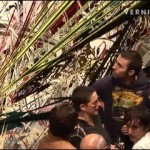The artist Tavares Strachan represents The Bahamas in the nation’s inaugural pavilion at the 55th International Art Exhibition – La Biennale di Venezia 2013. Curated by Jean Crutchfield and Robert Hobbs, Tavares Strachan conceived an immersive installation that includes different media such as neon signs, video, sculpture, and painting, and surrounds the viewer by documentation of a reenactment of a historic narrative: the 1909 polar expedition of Robert Peary and Matthew Alexander Henson. This video provides you with an exhibition walkthrough and a short interview with Tavares Strachan.
Bahamas Pavilion at Venice Art Biennale 2013: Tavares Strachan. Walkthrough and interview with Tavares Strachan, Professional Preview, May 29, 2013.
> Right-click (Mac: ctrl-click) this link to download Quicktime video file.
More info from the exhibition website:
Strachan specifically explores often-invisible shifts in cultures, physical environments, and recounted histories over both space and time, in the wake of globalization and narratives of progress. Three geographically and culturally disparate sites””the Venice Arsenale, downtown Nassau, and the North Pole””will momentarily coexist in the Bahamian pavilion.
The main exhibition space will feature an immersive installation, in which the viewer is surrounded by documentation of a reenactment of a historic narrative: the 1909 polar expedition of Robert Peary and Matthew Alexander Henson. Henson, Peary’s associate, is often credited as the first American to reach the pole. However, various written and oral iterations of that journey””whether Henson reached the Pole before the physically incapacitated Peary, whether Henson planted the American flag, and their complex relationship to one another and to Inuit communities””remain fluid and contested, more reflective of shifting ideologies than historic truth. Several other works in the installation will speak to the idea of displacement more directly, immediately confronting the viewer with the problematics of belonging and place. “I’m fascinated by the idea of being in two or more places at once, and exploring difference that way,” says Strachan. “The way that the Venice Biennale, historically and now, deploys the idea of “difference” as cultural tourism is an interesting problem to work with.
Tavares Strachan was born in 1979 in Nassau, Bahamas. After studying painting and liberal arts at both College of the Bahamas in Nassau and at Brown, he received a BFA from the Rhode Island School of Design, where he studied glass, and an MFA in sculpture from Yale University. Recurring themes in Strachan’s work include invisibility, displacement (both physical and metaphorical), and the capacity of both persons and matter to withstand inhospitable environments. Strachan’s work emphasizes the migratory, cross-cultural nature of contemporary artistic production, and unsettles canonized histories and geographies.
One of Strachan’s most iconic projects, The Distance Between What We Have and What We Want (2006), consisted of a 4.5-ton block of ice. Harvested in a river near Mount McKinley, then shipped Federal Express to the Bahamas, it was exhibited in transparent, freezer at a primary school in Nassau, where solar power kept it frozen. Over the past decade, Strachan’s explorations have expanded to both outer space and under water. A major focus has been orthostatic tolerance””the body’s ability to circumvent hypotension and withstand pressure during gravitational stress, often caused by quick changes of altitude, or the more extreme circumstances of being launched into the earth’s stratosphere or submerged to the oceans’ depths.
Strachan’s research on the topic has extended to hands-on training at the Yuri Gagarin Russian State Science Research Cosmonaut Training Center in Star City, Russia; a journey to the Arctic in commemoration of the 1909 journey of African-American explorer Matthew Henson; and a residency at the Massachusetts Institute of Technology, where he worked with some of the institution’s cutting-edge scientists. It also led to the establishment of the nascent Bahamian Aerospace and Sea Exploration Center in the Bahamas (BASEC). In the course of working with BASEC, Strachan has made several rockets wholly from Bahamian natural resources (glass from beach sand, and fuel from sugarcane) and launched them 15 to 20 miles into the earth’s stratosphere, before collecting and presenting their fallen remnants as sculptural relics.
Last year a 20,000-square-foot overview of Strachan’s work from 2003-2011, subtitled Seen/Unseen,was presented at an undisclosed New York City location and was closed to the public. Tavares Strachan: seen/unseen is fully documented with a forthcoming catalogue, designed by Stefan Sagmeister. Strachan’s solo exhibitions include Orthostatic Tolerance: It Might Not Be Such a Bad Idea if I Never Went Home Again, MIT List Visual Arts Center, Cambridge, MA (2010); Orthostatic Tolerance: Launching from an Infinite Distance, Grand Arts, Kansas City, MO (2010); Tavares Strachan: Orthostatic Tolerance, the Institute of Contemporary Art, University of Pennsylvania, Philadelphia (2009); Where We Are is Always Miles Away, The Luggage Store, San Francisco, CA (2006); and The Difference Between What We Have and What We Want, Albury Sayle Primary School, Nassau, The Bahamas (2006).
Strachan lives and works in New York City.




